Ethical Behavior: Leadership, Structure, and Decision-Making
VerifiedAdded on 2019/10/18
|8
|1980
|791
Essay
AI Summary
This essay delves into the multifaceted realm of ethics in management, exploring its definition, relationship with behavior, and the influence of law and freedom of choice. It elucidates various approaches to evaluating ethical behavior, including utilitarian, moral rights, justice, and individualism frameworks. Furthermore, the essay examines the factors that shape a manager's ethical decision-making process, such as personality traits and personal values. It also investigates the crucial roles of leadership, organizational structure, and systems in fostering ethical organizations. The content provides a comprehensive overview of how to create and maintain ethical standards within a business environment.
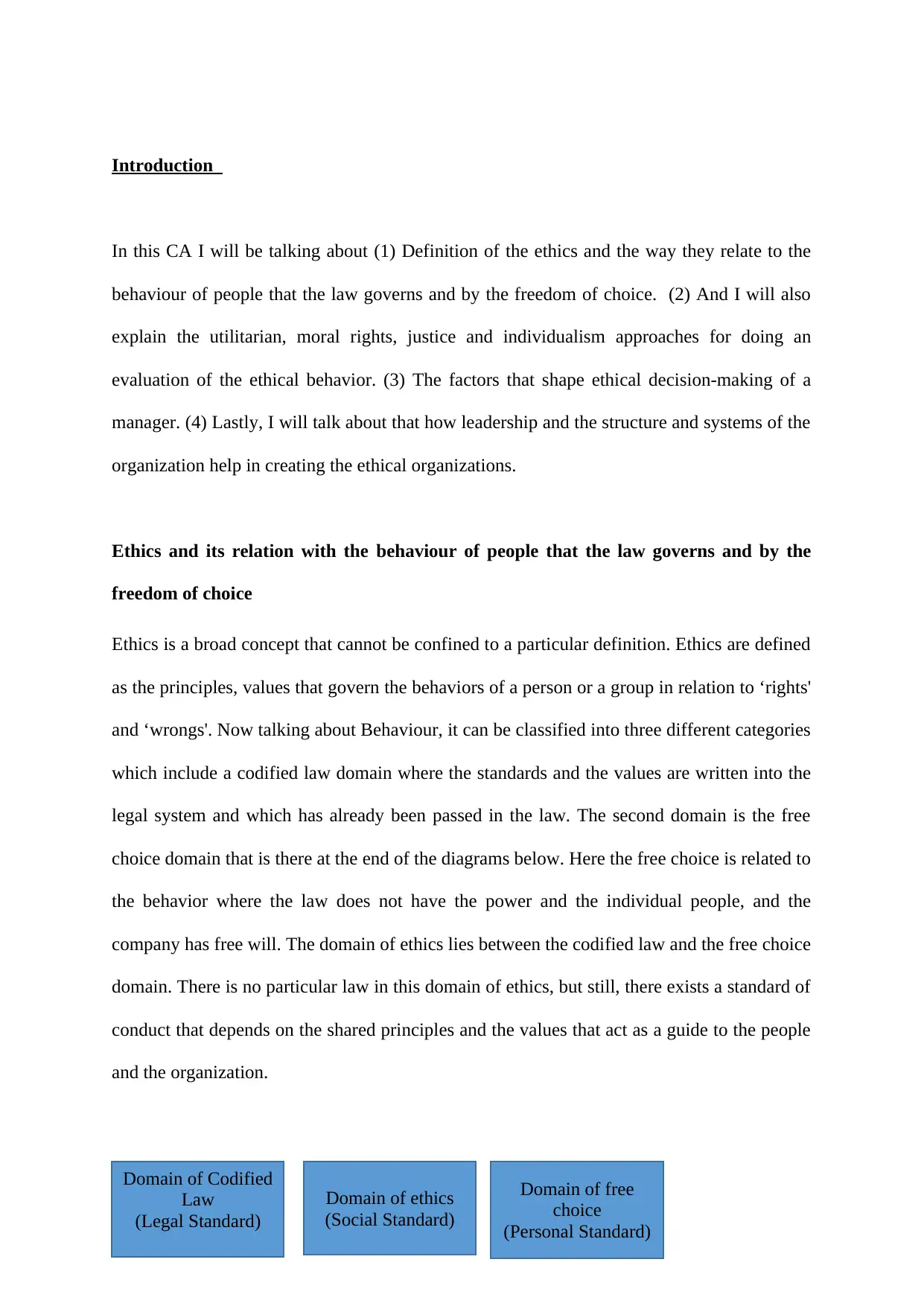
Introduction
In this CA I will be talking about (1) Definition of the ethics and the way they relate to the
behaviour of people that the law governs and by the freedom of choice. (2) And I will also
explain the utilitarian, moral rights, justice and individualism approaches for doing an
evaluation of the ethical behavior. (3) The factors that shape ethical decision-making of a
manager. (4) Lastly, I will talk about that how leadership and the structure and systems of the
organization help in creating the ethical organizations.
Ethics and its relation with the behaviour of people that the law governs and by the
freedom of choice
Ethics is a broad concept that cannot be confined to a particular definition. Ethics are defined
as the principles, values that govern the behaviors of a person or a group in relation to ‘rights'
and ‘wrongs'. Now talking about Behaviour, it can be classified into three different categories
which include a codified law domain where the standards and the values are written into the
legal system and which has already been passed in the law. The second domain is the free
choice domain that is there at the end of the diagrams below. Here the free choice is related to
the behavior where the law does not have the power and the individual people, and the
company has free will. The domain of ethics lies between the codified law and the free choice
domain. There is no particular law in this domain of ethics, but still, there exists a standard of
conduct that depends on the shared principles and the values that act as a guide to the people
and the organization.
Domain of Codified
Law
(Legal Standard)
Domain of ethics
(Social Standard)
Domain of free
choice
(Personal Standard)
In this CA I will be talking about (1) Definition of the ethics and the way they relate to the
behaviour of people that the law governs and by the freedom of choice. (2) And I will also
explain the utilitarian, moral rights, justice and individualism approaches for doing an
evaluation of the ethical behavior. (3) The factors that shape ethical decision-making of a
manager. (4) Lastly, I will talk about that how leadership and the structure and systems of the
organization help in creating the ethical organizations.
Ethics and its relation with the behaviour of people that the law governs and by the
freedom of choice
Ethics is a broad concept that cannot be confined to a particular definition. Ethics are defined
as the principles, values that govern the behaviors of a person or a group in relation to ‘rights'
and ‘wrongs'. Now talking about Behaviour, it can be classified into three different categories
which include a codified law domain where the standards and the values are written into the
legal system and which has already been passed in the law. The second domain is the free
choice domain that is there at the end of the diagrams below. Here the free choice is related to
the behavior where the law does not have the power and the individual people, and the
company has free will. The domain of ethics lies between the codified law and the free choice
domain. There is no particular law in this domain of ethics, but still, there exists a standard of
conduct that depends on the shared principles and the values that act as a guide to the people
and the organization.
Domain of Codified
Law
(Legal Standard)
Domain of ethics
(Social Standard)
Domain of free
choice
(Personal Standard)
Paraphrase This Document
Need a fresh take? Get an instant paraphrase of this document with our AI Paraphraser
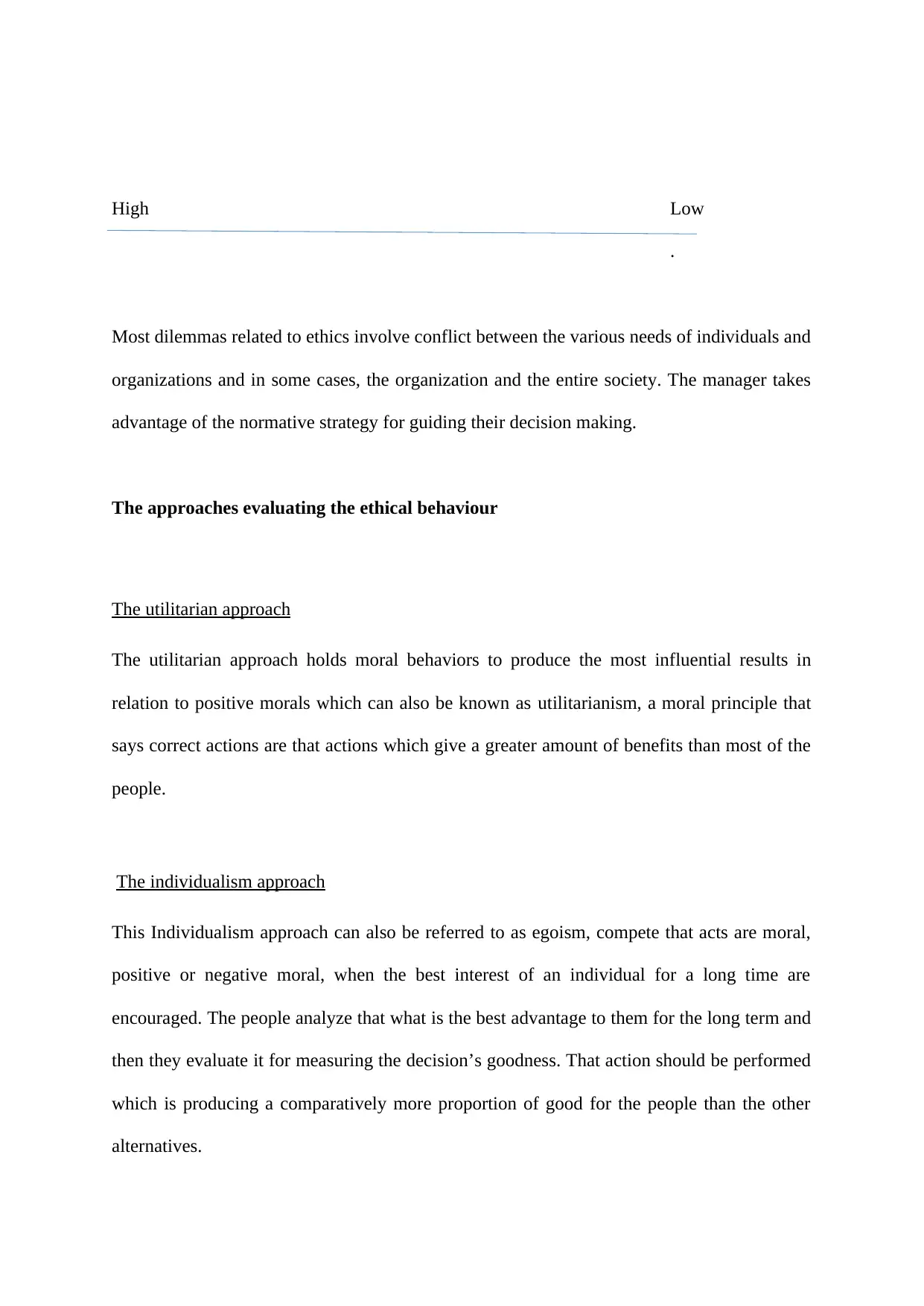
High Low
.
Most dilemmas related to ethics involve conflict between the various needs of individuals and
organizations and in some cases, the organization and the entire society. The manager takes
advantage of the normative strategy for guiding their decision making.
The approaches evaluating the ethical behaviour
The utilitarian approach
The utilitarian approach holds moral behaviors to produce the most influential results in
relation to positive morals which can also be known as utilitarianism, a moral principle that
says correct actions are that actions which give a greater amount of benefits than most of the
people.
The individualism approach
This Individualism approach can also be referred to as egoism, compete that acts are moral,
positive or negative moral, when the best interest of an individual for a long time are
encouraged. The people analyze that what is the best advantage to them for the long term and
then they evaluate it for measuring the decision’s goodness. That action should be performed
which is producing a comparatively more proportion of good for the people than the other
alternatives.
.
Most dilemmas related to ethics involve conflict between the various needs of individuals and
organizations and in some cases, the organization and the entire society. The manager takes
advantage of the normative strategy for guiding their decision making.
The approaches evaluating the ethical behaviour
The utilitarian approach
The utilitarian approach holds moral behaviors to produce the most influential results in
relation to positive morals which can also be known as utilitarianism, a moral principle that
says correct actions are that actions which give a greater amount of benefits than most of the
people.
The individualism approach
This Individualism approach can also be referred to as egoism, compete that acts are moral,
positive or negative moral, when the best interest of an individual for a long time are
encouraged. The people analyze that what is the best advantage to them for the long term and
then they evaluate it for measuring the decision’s goodness. That action should be performed
which is producing a comparatively more proportion of good for the people than the other
alternatives.
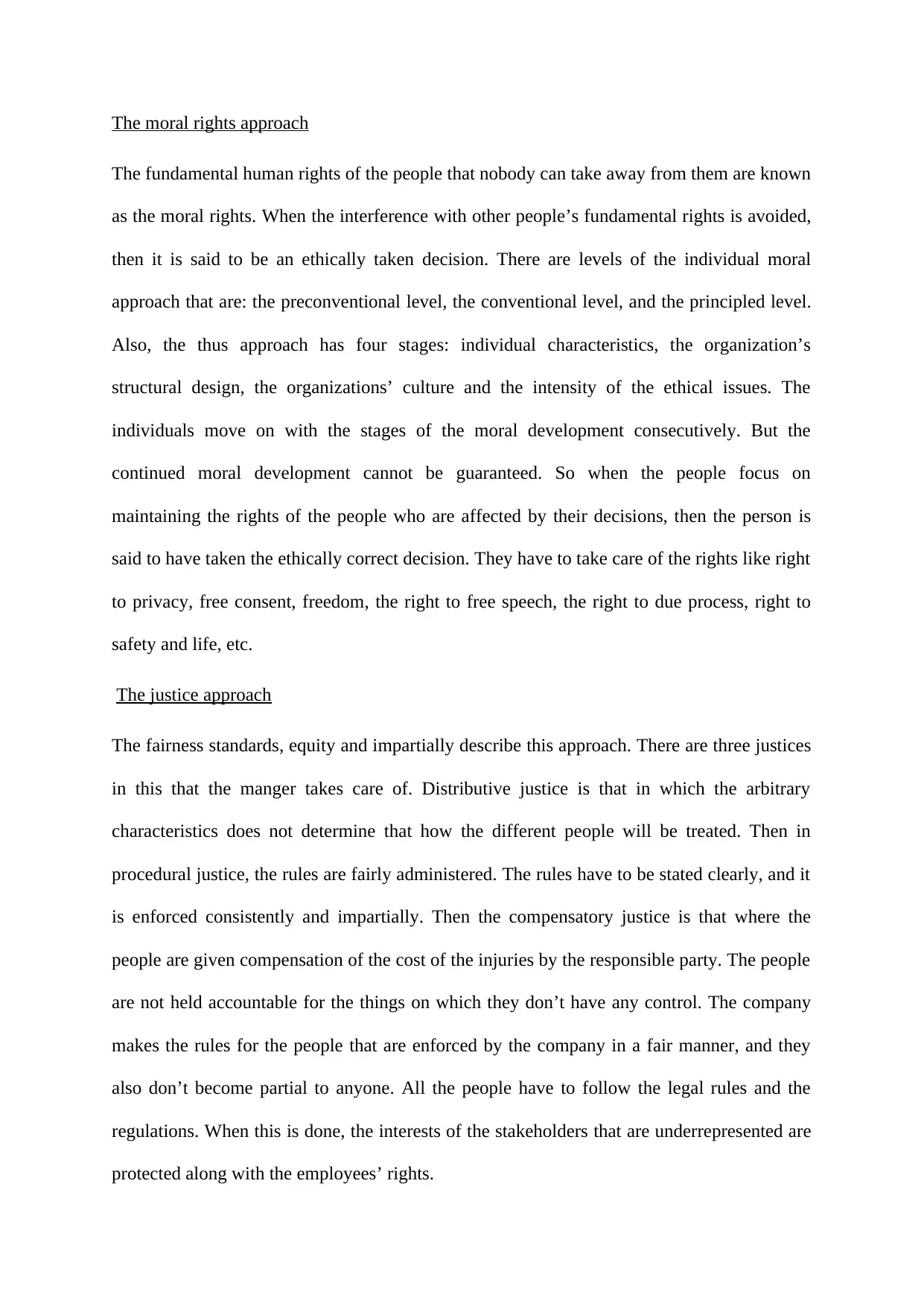
The moral rights approach
The fundamental human rights of the people that nobody can take away from them are known
as the moral rights. When the interference with other people’s fundamental rights is avoided,
then it is said to be an ethically taken decision. There are levels of the individual moral
approach that are: the preconventional level, the conventional level, and the principled level.
Also, the thus approach has four stages: individual characteristics, the organization’s
structural design, the organizations’ culture and the intensity of the ethical issues. The
individuals move on with the stages of the moral development consecutively. But the
continued moral development cannot be guaranteed. So when the people focus on
maintaining the rights of the people who are affected by their decisions, then the person is
said to have taken the ethically correct decision. They have to take care of the rights like right
to privacy, free consent, freedom, the right to free speech, the right to due process, right to
safety and life, etc.
The justice approach
The fairness standards, equity and impartially describe this approach. There are three justices
in this that the manger takes care of. Distributive justice is that in which the arbitrary
characteristics does not determine that how the different people will be treated. Then in
procedural justice, the rules are fairly administered. The rules have to be stated clearly, and it
is enforced consistently and impartially. Then the compensatory justice is that where the
people are given compensation of the cost of the injuries by the responsible party. The people
are not held accountable for the things on which they don’t have any control. The company
makes the rules for the people that are enforced by the company in a fair manner, and they
also don’t become partial to anyone. All the people have to follow the legal rules and the
regulations. When this is done, the interests of the stakeholders that are underrepresented are
protected along with the employees’ rights.
The fundamental human rights of the people that nobody can take away from them are known
as the moral rights. When the interference with other people’s fundamental rights is avoided,
then it is said to be an ethically taken decision. There are levels of the individual moral
approach that are: the preconventional level, the conventional level, and the principled level.
Also, the thus approach has four stages: individual characteristics, the organization’s
structural design, the organizations’ culture and the intensity of the ethical issues. The
individuals move on with the stages of the moral development consecutively. But the
continued moral development cannot be guaranteed. So when the people focus on
maintaining the rights of the people who are affected by their decisions, then the person is
said to have taken the ethically correct decision. They have to take care of the rights like right
to privacy, free consent, freedom, the right to free speech, the right to due process, right to
safety and life, etc.
The justice approach
The fairness standards, equity and impartially describe this approach. There are three justices
in this that the manger takes care of. Distributive justice is that in which the arbitrary
characteristics does not determine that how the different people will be treated. Then in
procedural justice, the rules are fairly administered. The rules have to be stated clearly, and it
is enforced consistently and impartially. Then the compensatory justice is that where the
people are given compensation of the cost of the injuries by the responsible party. The people
are not held accountable for the things on which they don’t have any control. The company
makes the rules for the people that are enforced by the company in a fair manner, and they
also don’t become partial to anyone. All the people have to follow the legal rules and the
regulations. When this is done, the interests of the stakeholders that are underrepresented are
protected along with the employees’ rights.
⊘ This is a preview!⊘
Do you want full access?
Subscribe today to unlock all pages.

Trusted by 1+ million students worldwide
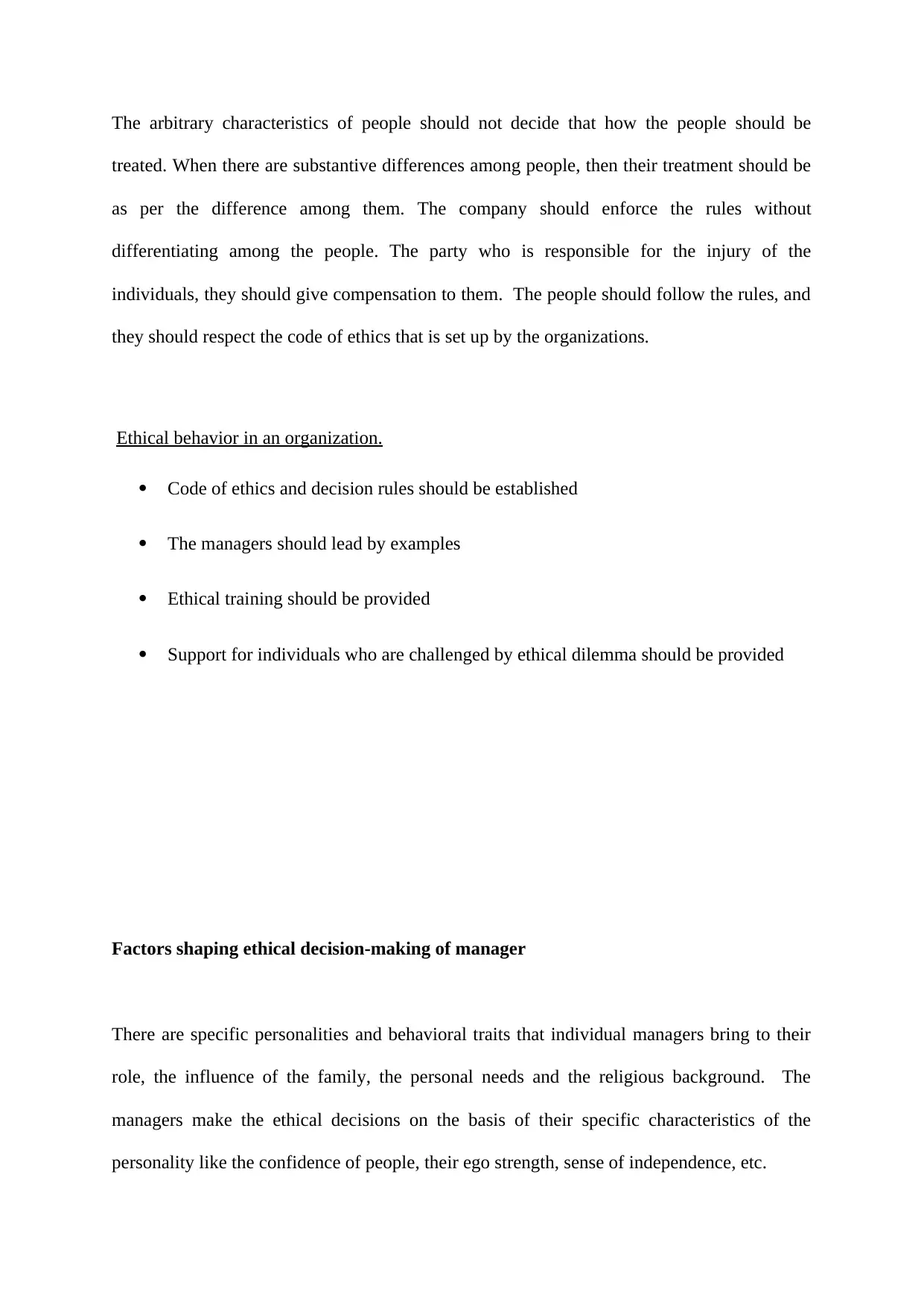
The arbitrary characteristics of people should not decide that how the people should be
treated. When there are substantive differences among people, then their treatment should be
as per the difference among them. The company should enforce the rules without
differentiating among the people. The party who is responsible for the injury of the
individuals, they should give compensation to them. The people should follow the rules, and
they should respect the code of ethics that is set up by the organizations.
Ethical behavior in an organization.
Code of ethics and decision rules should be established
The managers should lead by examples
Ethical training should be provided
Support for individuals who are challenged by ethical dilemma should be provided
Factors shaping ethical decision-making of manager
There are specific personalities and behavioral traits that individual managers bring to their
role, the influence of the family, the personal needs and the religious background. The
managers make the ethical decisions on the basis of their specific characteristics of the
personality like the confidence of people, their ego strength, sense of independence, etc.
treated. When there are substantive differences among people, then their treatment should be
as per the difference among them. The company should enforce the rules without
differentiating among the people. The party who is responsible for the injury of the
individuals, they should give compensation to them. The people should follow the rules, and
they should respect the code of ethics that is set up by the organizations.
Ethical behavior in an organization.
Code of ethics and decision rules should be established
The managers should lead by examples
Ethical training should be provided
Support for individuals who are challenged by ethical dilemma should be provided
Factors shaping ethical decision-making of manager
There are specific personalities and behavioral traits that individual managers bring to their
role, the influence of the family, the personal needs and the religious background. The
managers make the ethical decisions on the basis of their specific characteristics of the
personality like the confidence of people, their ego strength, sense of independence, etc.
Paraphrase This Document
Need a fresh take? Get an instant paraphrase of this document with our AI Paraphraser
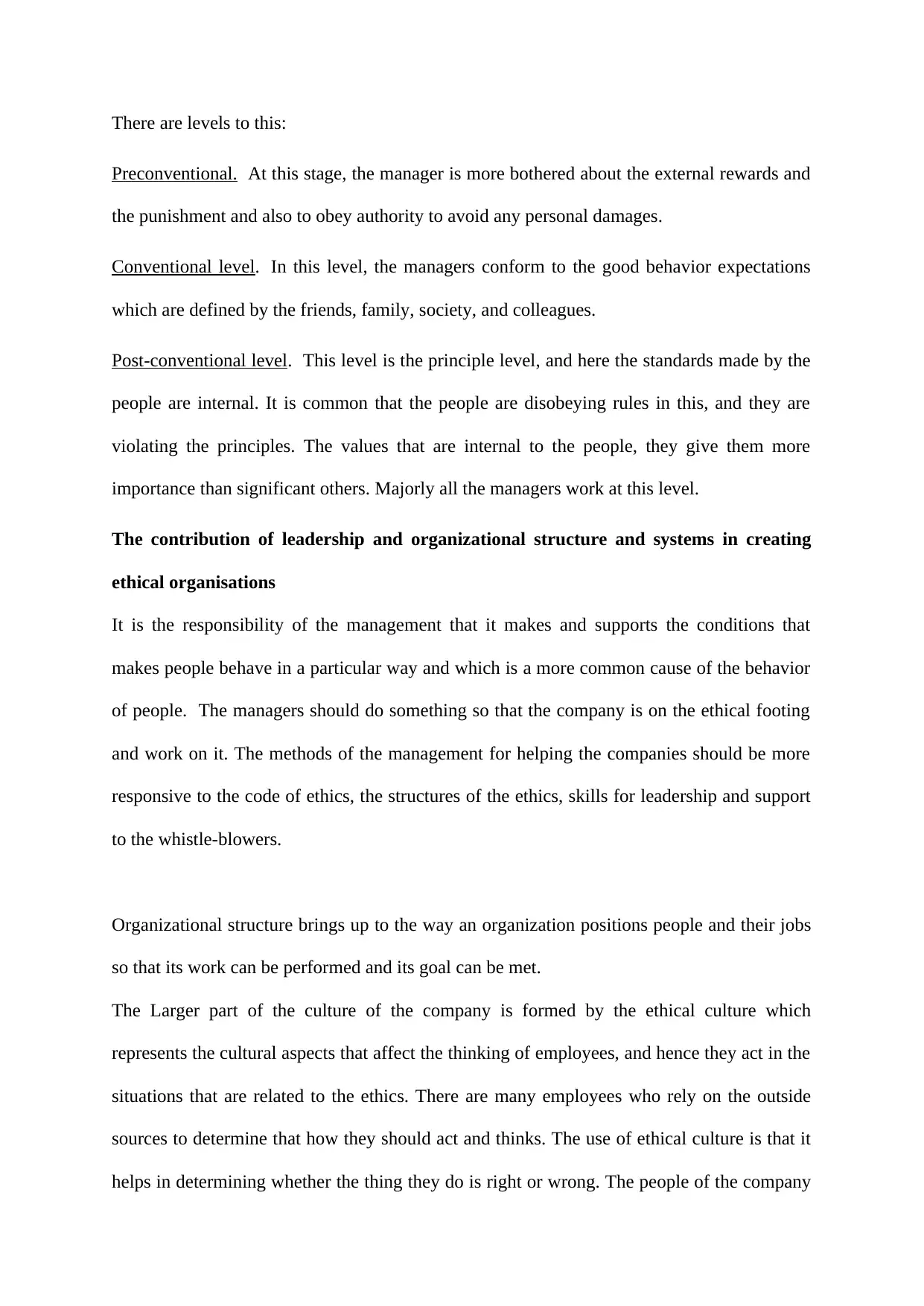
There are levels to this:
Preconventional. At this stage, the manager is more bothered about the external rewards and
the punishment and also to obey authority to avoid any personal damages.
Conventional level. In this level, the managers conform to the good behavior expectations
which are defined by the friends, family, society, and colleagues.
Post-conventional level. This level is the principle level, and here the standards made by the
people are internal. It is common that the people are disobeying rules in this, and they are
violating the principles. The values that are internal to the people, they give them more
importance than significant others. Majorly all the managers work at this level.
The contribution of leadership and organizational structure and systems in creating
ethical organisations
It is the responsibility of the management that it makes and supports the conditions that
makes people behave in a particular way and which is a more common cause of the behavior
of people. The managers should do something so that the company is on the ethical footing
and work on it. The methods of the management for helping the companies should be more
responsive to the code of ethics, the structures of the ethics, skills for leadership and support
to the whistle-blowers.
Organizational structure brings up to the way an organization positions people and their jobs
so that its work can be performed and its goal can be met.
The Larger part of the culture of the company is formed by the ethical culture which
represents the cultural aspects that affect the thinking of employees, and hence they act in the
situations that are related to the ethics. There are many employees who rely on the outside
sources to determine that how they should act and thinks. The use of ethical culture is that it
helps in determining whether the thing they do is right or wrong. The people of the company
Preconventional. At this stage, the manager is more bothered about the external rewards and
the punishment and also to obey authority to avoid any personal damages.
Conventional level. In this level, the managers conform to the good behavior expectations
which are defined by the friends, family, society, and colleagues.
Post-conventional level. This level is the principle level, and here the standards made by the
people are internal. It is common that the people are disobeying rules in this, and they are
violating the principles. The values that are internal to the people, they give them more
importance than significant others. Majorly all the managers work at this level.
The contribution of leadership and organizational structure and systems in creating
ethical organisations
It is the responsibility of the management that it makes and supports the conditions that
makes people behave in a particular way and which is a more common cause of the behavior
of people. The managers should do something so that the company is on the ethical footing
and work on it. The methods of the management for helping the companies should be more
responsive to the code of ethics, the structures of the ethics, skills for leadership and support
to the whistle-blowers.
Organizational structure brings up to the way an organization positions people and their jobs
so that its work can be performed and its goal can be met.
The Larger part of the culture of the company is formed by the ethical culture which
represents the cultural aspects that affect the thinking of employees, and hence they act in the
situations that are related to the ethics. There are many employees who rely on the outside
sources to determine that how they should act and thinks. The use of ethical culture is that it
helps in determining whether the thing they do is right or wrong. The people of the company
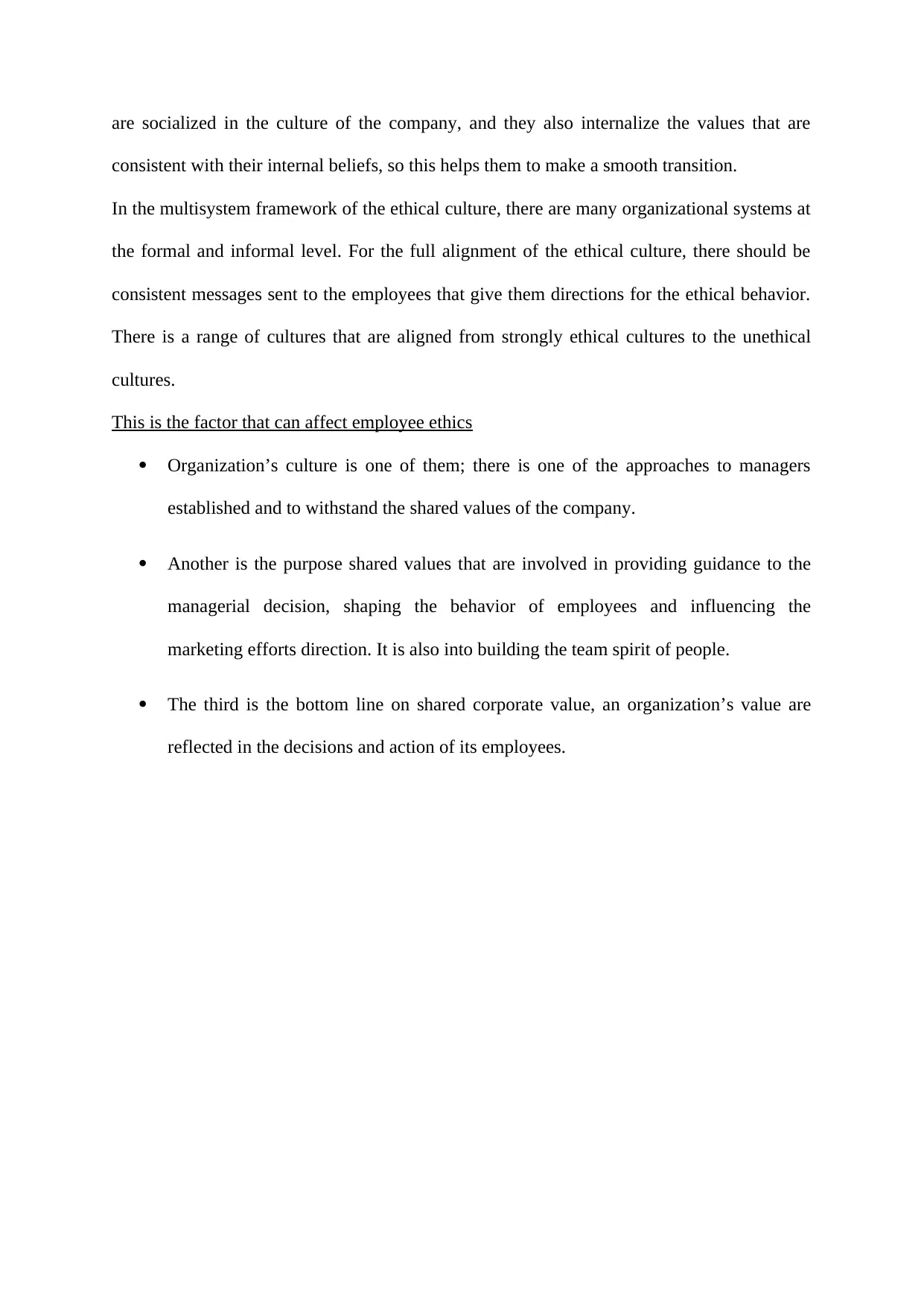
are socialized in the culture of the company, and they also internalize the values that are
consistent with their internal beliefs, so this helps them to make a smooth transition.
In the multisystem framework of the ethical culture, there are many organizational systems at
the formal and informal level. For the full alignment of the ethical culture, there should be
consistent messages sent to the employees that give them directions for the ethical behavior.
There is a range of cultures that are aligned from strongly ethical cultures to the unethical
cultures.
This is the factor that can affect employee ethics
Organization’s culture is one of them; there is one of the approaches to managers
established and to withstand the shared values of the company.
Another is the purpose shared values that are involved in providing guidance to the
managerial decision, shaping the behavior of employees and influencing the
marketing efforts direction. It is also into building the team spirit of people.
The third is the bottom line on shared corporate value, an organization’s value are
reflected in the decisions and action of its employees.
consistent with their internal beliefs, so this helps them to make a smooth transition.
In the multisystem framework of the ethical culture, there are many organizational systems at
the formal and informal level. For the full alignment of the ethical culture, there should be
consistent messages sent to the employees that give them directions for the ethical behavior.
There is a range of cultures that are aligned from strongly ethical cultures to the unethical
cultures.
This is the factor that can affect employee ethics
Organization’s culture is one of them; there is one of the approaches to managers
established and to withstand the shared values of the company.
Another is the purpose shared values that are involved in providing guidance to the
managerial decision, shaping the behavior of employees and influencing the
marketing efforts direction. It is also into building the team spirit of people.
The third is the bottom line on shared corporate value, an organization’s value are
reflected in the decisions and action of its employees.
⊘ This is a preview!⊘
Do you want full access?
Subscribe today to unlock all pages.

Trusted by 1+ million students worldwide
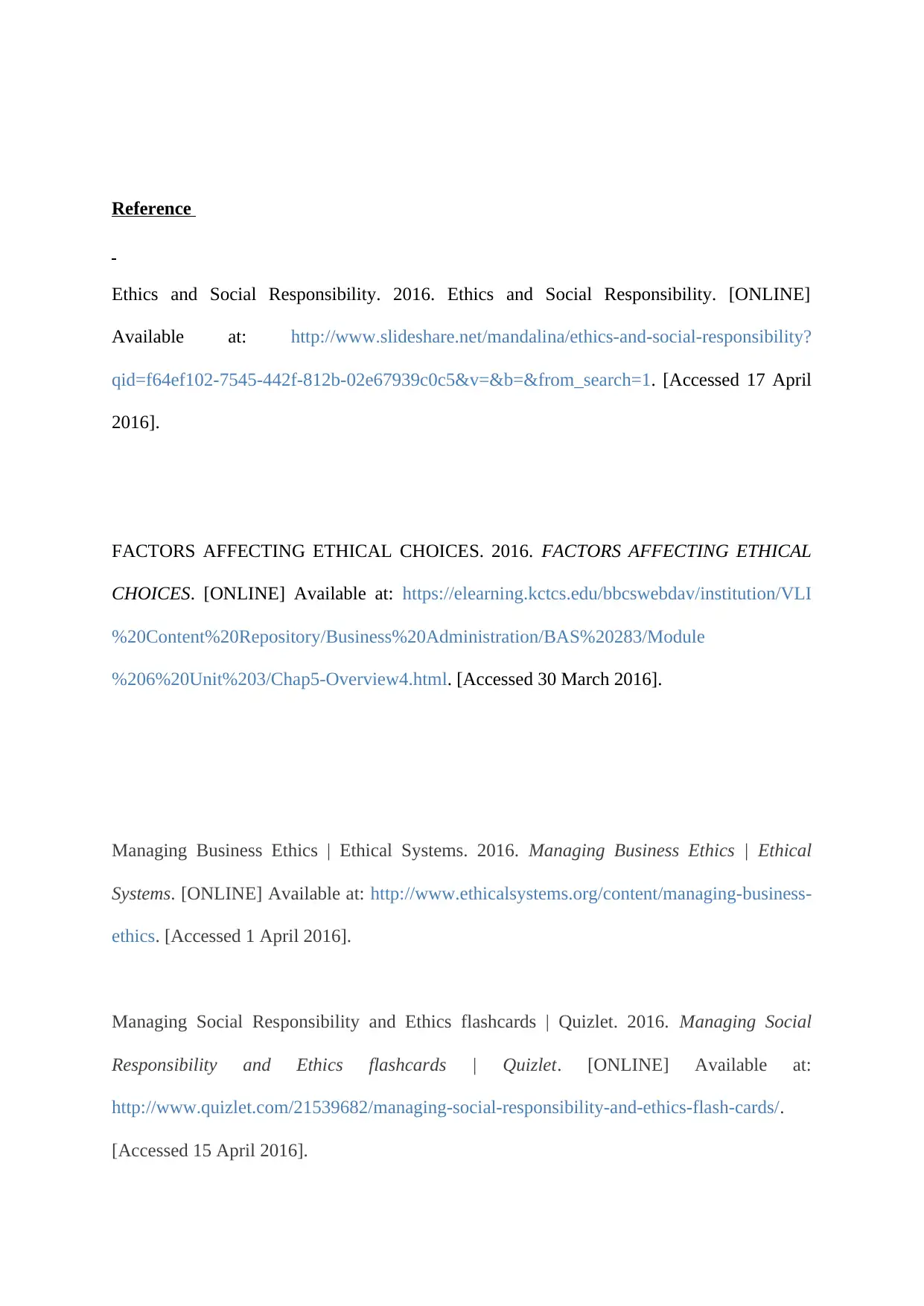
Reference
Ethics and Social Responsibility. 2016. Ethics and Social Responsibility. [ONLINE]
Available at: http://www.slideshare.net/mandalina/ethics-and-social-responsibility?
qid=f64ef102-7545-442f-812b-02e67939c0c5&v=&b=&from_search=1. [Accessed 17 April
2016].
FACTORS AFFECTING ETHICAL CHOICES. 2016. FACTORS AFFECTING ETHICAL
CHOICES. [ONLINE] Available at: https://elearning.kctcs.edu/bbcswebdav/institution/VLI
%20Content%20Repository/Business%20Administration/BAS%20283/Module
%206%20Unit%203/Chap5-Overview4.html. [Accessed 30 March 2016].
Managing Business Ethics | Ethical Systems. 2016. Managing Business Ethics | Ethical
Systems. [ONLINE] Available at: http://www.ethicalsystems.org/content/managing-business-
ethics. [Accessed 1 April 2016].
Managing Social Responsibility and Ethics flashcards | Quizlet. 2016. Managing Social
Responsibility and Ethics flashcards | Quizlet. [ONLINE] Available at:
http://www.quizlet.com/21539682/managing-social-responsibility-and-ethics-flash-cards/.
[Accessed 15 April 2016].
Ethics and Social Responsibility. 2016. Ethics and Social Responsibility. [ONLINE]
Available at: http://www.slideshare.net/mandalina/ethics-and-social-responsibility?
qid=f64ef102-7545-442f-812b-02e67939c0c5&v=&b=&from_search=1. [Accessed 17 April
2016].
FACTORS AFFECTING ETHICAL CHOICES. 2016. FACTORS AFFECTING ETHICAL
CHOICES. [ONLINE] Available at: https://elearning.kctcs.edu/bbcswebdav/institution/VLI
%20Content%20Repository/Business%20Administration/BAS%20283/Module
%206%20Unit%203/Chap5-Overview4.html. [Accessed 30 March 2016].
Managing Business Ethics | Ethical Systems. 2016. Managing Business Ethics | Ethical
Systems. [ONLINE] Available at: http://www.ethicalsystems.org/content/managing-business-
ethics. [Accessed 1 April 2016].
Managing Social Responsibility and Ethics flashcards | Quizlet. 2016. Managing Social
Responsibility and Ethics flashcards | Quizlet. [ONLINE] Available at:
http://www.quizlet.com/21539682/managing-social-responsibility-and-ethics-flash-cards/.
[Accessed 15 April 2016].
Paraphrase This Document
Need a fresh take? Get an instant paraphrase of this document with our AI Paraphraser
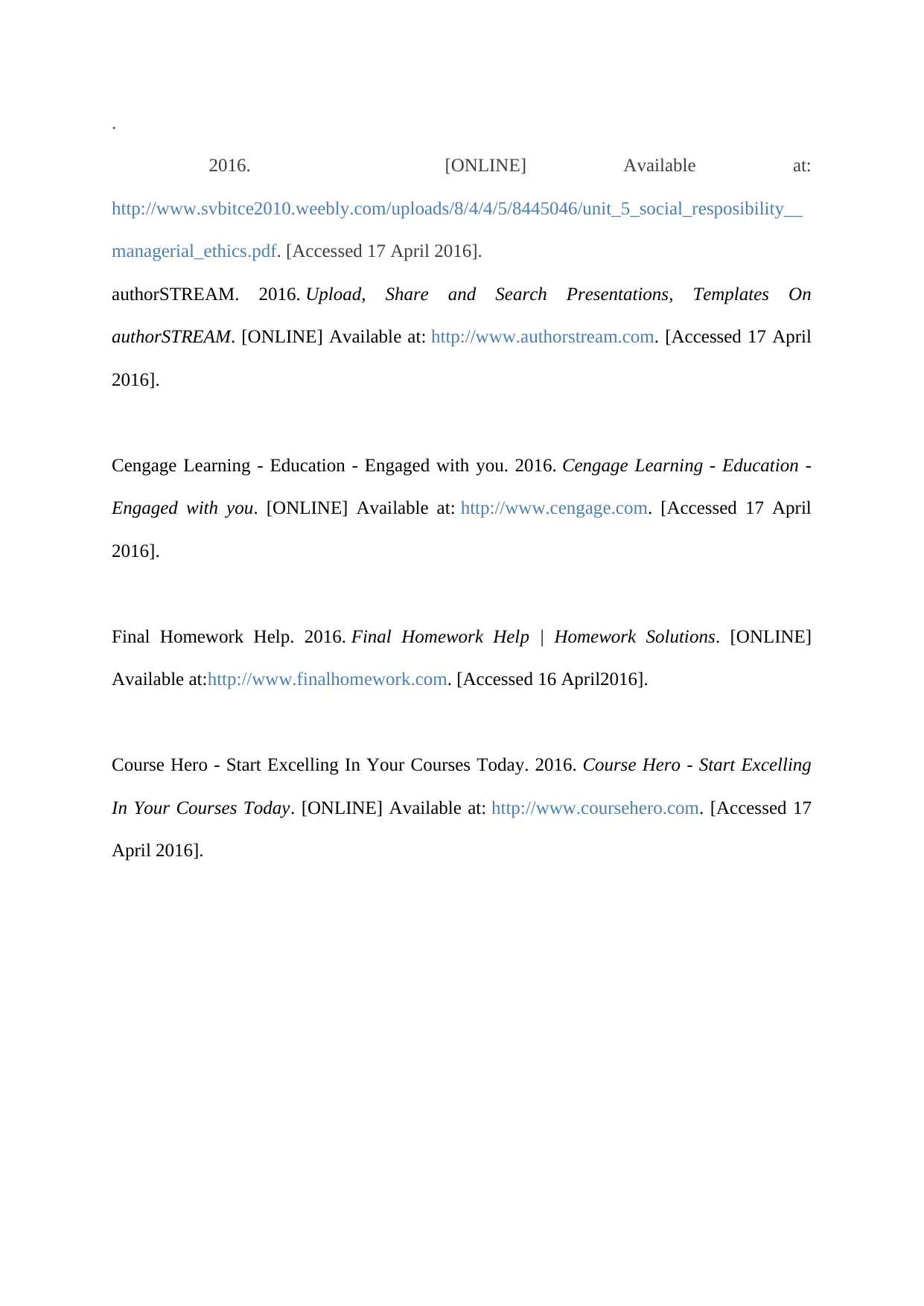
.
2016. [ONLINE] Available at:
http://www.svbitce2010.weebly.com/uploads/8/4/4/5/8445046/unit_5_social_resposibility__
managerial_ethics.pdf. [Accessed 17 April 2016].
authorSTREAM. 2016. Upload, Share and Search Presentations, Templates On
authorSTREAM. [ONLINE] Available at: http://www.authorstream.com. [Accessed 17 April
2016].
Cengage Learning - Education - Engaged with you. 2016. Cengage Learning - Education -
Engaged with you. [ONLINE] Available at: http://www.cengage.com. [Accessed 17 April
2016].
Final Homework Help. 2016. Final Homework Help | Homework Solutions. [ONLINE]
Available at:http://www.finalhomework.com. [Accessed 16 April2016].
Course Hero - Start Excelling In Your Courses Today. 2016. Course Hero - Start Excelling
In Your Courses Today. [ONLINE] Available at: http://www.coursehero.com. [Accessed 17
April 2016].
2016. [ONLINE] Available at:
http://www.svbitce2010.weebly.com/uploads/8/4/4/5/8445046/unit_5_social_resposibility__
managerial_ethics.pdf. [Accessed 17 April 2016].
authorSTREAM. 2016. Upload, Share and Search Presentations, Templates On
authorSTREAM. [ONLINE] Available at: http://www.authorstream.com. [Accessed 17 April
2016].
Cengage Learning - Education - Engaged with you. 2016. Cengage Learning - Education -
Engaged with you. [ONLINE] Available at: http://www.cengage.com. [Accessed 17 April
2016].
Final Homework Help. 2016. Final Homework Help | Homework Solutions. [ONLINE]
Available at:http://www.finalhomework.com. [Accessed 16 April2016].
Course Hero - Start Excelling In Your Courses Today. 2016. Course Hero - Start Excelling
In Your Courses Today. [ONLINE] Available at: http://www.coursehero.com. [Accessed 17
April 2016].
1 out of 8
Related Documents
Your All-in-One AI-Powered Toolkit for Academic Success.
+13062052269
info@desklib.com
Available 24*7 on WhatsApp / Email
![[object Object]](/_next/static/media/star-bottom.7253800d.svg)
Unlock your academic potential
Copyright © 2020–2025 A2Z Services. All Rights Reserved. Developed and managed by ZUCOL.





